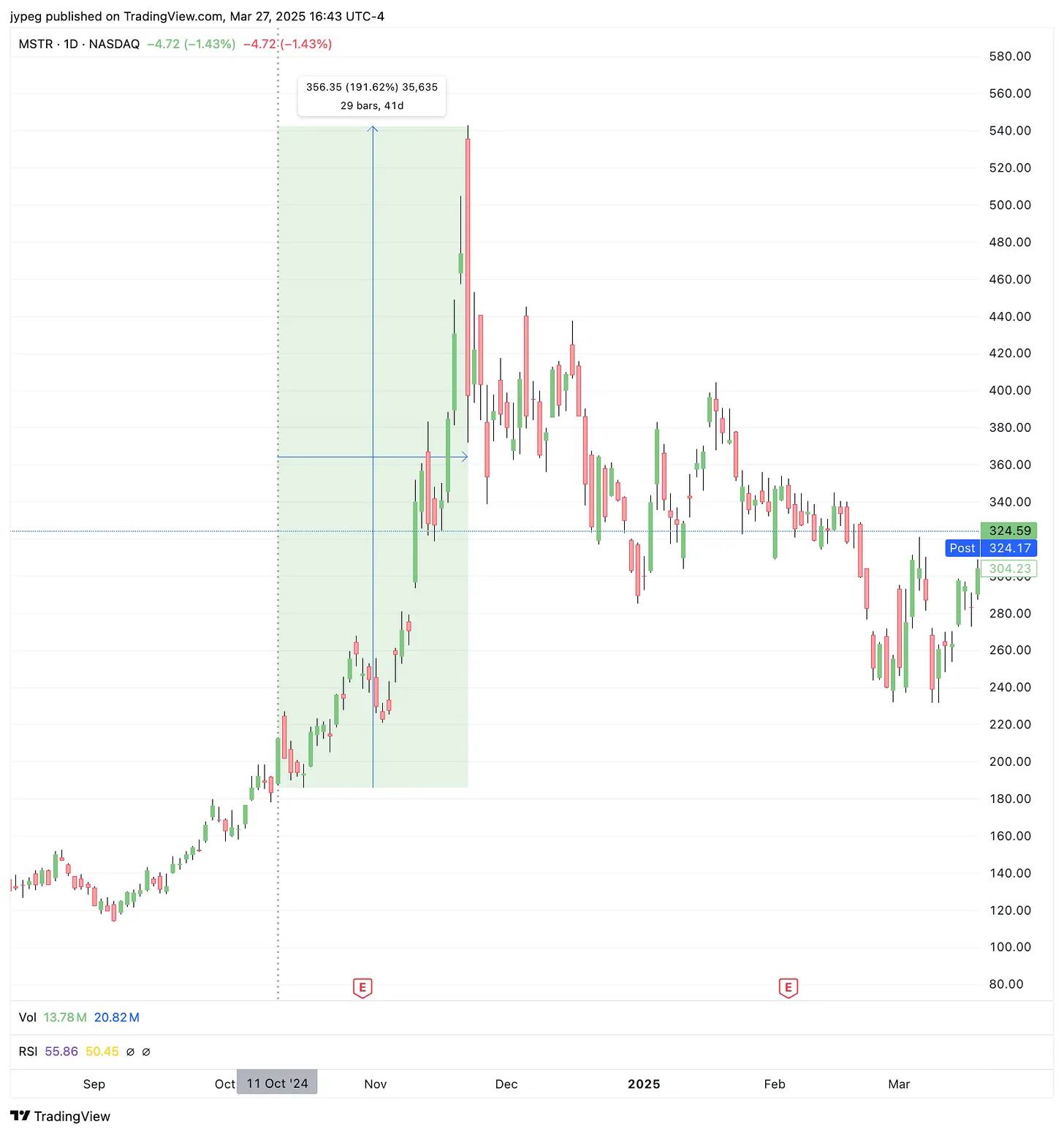Dismantling Saylor's Bitcoin Finance Magic: Stock Price has risen 3 times the highest since October last year

Reprinted from panewslab
03/31/2025·1MAuthor: JAY
Compiled by: Deep Tide TechFlow
Strategy (MSTR)’s share price has experienced dramatic volatility since October 2024. From $188 to $540, it achieved a nearly triple gain, but then fell back and stabilized at the low range of $300.
Behind this stock price trend is a series of important initiatives promoted by founder Michael Saylor, including changing the company's name to Strategy, purchasing more than 506,000 Bitcoins (BTC), and issuing two new preferred stocks, STRK and STRF.
However, there are many inaccurate interpretations on the market about how Strategy works. To help investors more clearly assess whether Saylor’s Bitcoin reserve strategy is sustainable, we try to simplify its core logic.

Saylor's Bitcoin Reserve Strategy: Two Key Points
Saylor's financial strategy can be summarized into the following two points:
Sell stock options and get a one-time profit
Strategy sets the exercise price to the range of 30% to 300% of the current share price by selling purchase or conversion options for MSTR stock, and collects full earnings in advance through structured trading. This is achieved mainly through the issuance of convertible bonds and preferred shares STRK and STRF.
Issuing additional stocks at the right time
Using the ATM (At-the-Market) mechanism, additional MSTR stocks are issued when market conditions are favorable to further raise funds.
It should be noted that Saylor does not explicitly plan to repay the principal of these options or bonds. His core goal is to maintain the long-term operation of the financing plan while paying interest until the share price of MSTR rises to the relevant exercise price.
The core advantage of this strategy lies in its highly flexible financing methods. Using this strategy, Saylor can select the best fundraising tool based on market conditions:
- When implicit volatility is high, convertible bonds are issued;
- When the net asset value of MSTR stock (NAV) has a high premium, additional shares will be issued through the ATM mechanism;
- If none of the above conditions are met, more preferred shares (such as STRK or STRF) will be issued.
The outside world may often have concerns about the high leverage risk of this strategy, but data suggest that this concern is not true. Here are the key financial data for MSTR:
- Market capitalization: US$85 billion;
- Bitcoin holdings market value: approximately US$44 billion (506,000 BTC);
- Total debt: US$8.2 billion, with an annual interest rate of only 0.421%, and an annual interest expenditure of approximately US$34 million;
- Preferred stock dividend expenditure: STRK is $58.4 million per year and STRF is $85 million per year.
By performing a ratio analysis of these data, it can be found that Saylor's leverage use is actually very limited and the debt costs are extremely low.
Bitcoin Reserve Strategy vs. Traditional Banking Model
Strategy's Bitcoin reserve strategy can be somewhat comparable to the operating model of traditional banks. The core operating logic of both is as follows:
Traditional banking model
Banks further amplify leverage through a partial reserve system, thereby increasing returns, but this model can occasionally lead to bank bankruptcy.
- Receive customer deposits;
- Use deposit funds to purchase "safe" government-backed debt (such as Treasury bills, mortgage-backed securities, etc.);
- The interest paid to the depositor is lower than the proceeds of the debt investment.
Bitcoin reserve strategy
Unlike traditional banks, Strategy's Bitcoin reserve strategy does not use too much leverage, because the government will not provide similar bailouts to the banking industry once problems arise.
- Raise funds (similar to bank receiving deposits);
- Buy Bitcoin with raised funds (rather than government-backed debt);
- Pay MSTR stock earnings and periodic interest or dividends to investors.
Despite the different operating methods, the core goal of both models is to achieve profitability through capital management. Banks rely on net interest spreads (the difference between debt investment income and deposit interest) to benefit part of the debt interest transferred by investors through the bank. Bitcoin reserve companies rely on Bitcoin’s capital appreciation, allowing investors to benefit from the volatility of Bitcoin’s price (refer to more detailed information to understand how this transaction works and why this model is beneficial to convertible bond buyers). This appreciation is mainly due to the rise in Bitcoin price or the depreciation of the US dollar relative to Bitcoin.
Future Potential of Bitcoin Reserve Strategy
Michael Saylor is one of the most determined advocates of Bitcoin reserve strategy. His asset management model has successfully attracted many companies to follow suit and prompted the U.S. government to begin exploring similar reserve strategies. The continued rise in MSTR and Bitcoin prices became the best "advertising" of this strategy, further promoting the market's recognition of the Bitcoin reserve concept.
Although there are still a few people who truly understand and accept the Saylor strategy at present, the market influence and sustainability of this strategy are increasing as Bitcoin and MSTR develop. Market attention and feedback in turn drive the success of the strategy, and this "reflexiveness" may bring longer-term development potential to Bitcoin reserve strategies.



 chaincatcher
chaincatcher